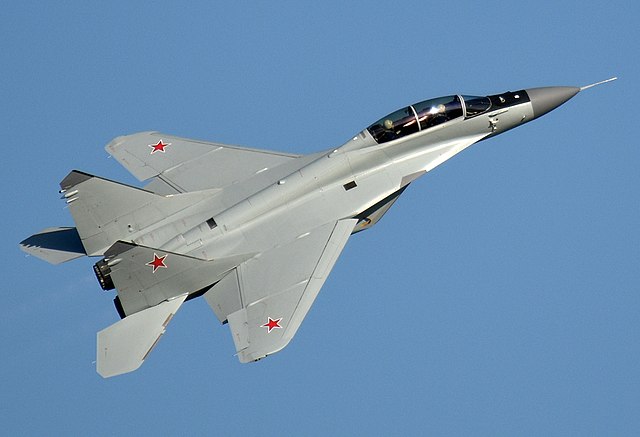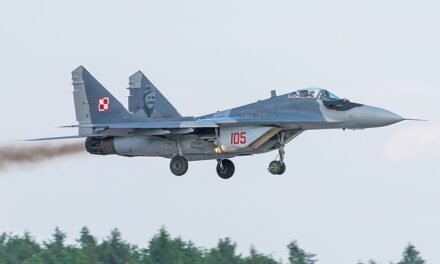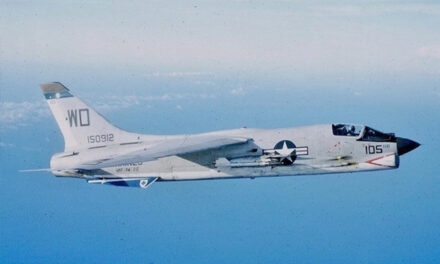MIG-33 ( MIG-29M ) Fulcrum
MIG-33 (MIG-29 product “9-15”) is the advanced variant of MIG-29, with the task to make multirole aircraft from the baseline plane. NATO reporting code is “Fulcrum-E”. Though the MIG-29 appeared impressive when it was first seen in Finland on 2 July 1986, it was then already a ten-year-old design. Previously, the MiG-29 had been seen only in drawings in the West. New MIG-29M or MIG-33 how is designated in the first place. Nine years later Mikoyan team flew the first prototype of the second updated version, which is a much greater advance than the MiG-29S. The airframe is redesigned, mechanical flight controls are replaced by a fly-by-wire system, glass’ cockpit, and powered by enhanced RD-33 ser.3M engines. This development resulted in a single-seat MIG-29M and a two-seat variant MiG-29MRCA.
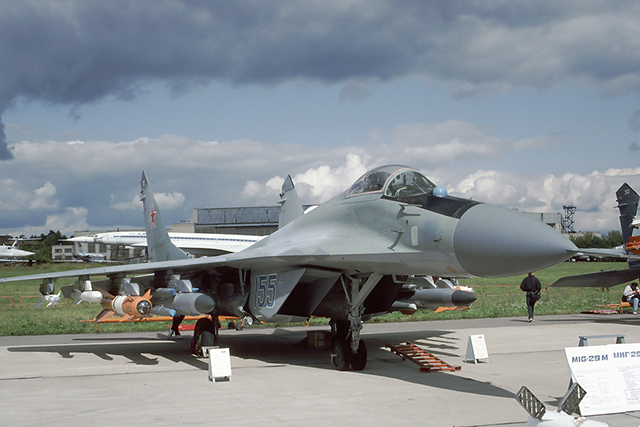
MIG-33 (MIG-29) radar is the Eazotron N010 Zhuk (beetle). In the air/air mode it offers the capability of simultaneously engaging four targets out often being tracked. It can illuminate targets for semi-active missiles, and also has a gunfire mode. It can provide target designation for the surface attack, terrain-following or avoidance, synthetic ground mapping, and various forms of position fixing. The REEK computer has a processing speed four times faster than that of the old MIG-29 radar N019M. The HUD-sight has a larger field of view. The SUV fire-control system is completed by the HMS (helmet-mounted sight), data processing speed is also multiplied by four.
Each wing is equipped for four pylons, compared with two in the MiG-29 and three in the MiG-29S. Ignoring the centreline tank, the underwing weapon load is increased to 4,500kg (9,921 lb), including the full range of Kh-25, Kh-29, and Kh-31 surface-attack missiles. More than half the items in the complete avionics suite are new or upgraded. The active jammer is Gardeniya-1.
Six of these models were built before 1990. They were constantly upgraded with various components and one received experimental vector thrust engines which eventually became the MiG-29OVT. The model was again renamed as MiG-29M.
MiG-29M2 / MiG-29MRCA
MiG-29M2 is a two-seat training variant of the MiG-29M. Design is used from never built model MiG-29UBM (“9-16”). MIG-29M2 has identical characteristics to MiG-29M, with a slightly reduced ferry range of 1,800 km.
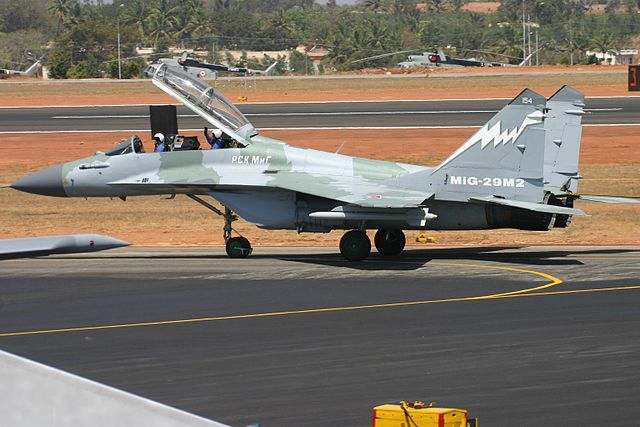
MiG-29OVT
One of the six pre-built MiG-29Ms before the collapse of the Soviet Union later received a thrust-vectoring engine and fly-by-wire technology. It served as a thrust-vectoring engine testbed and technology demonstrator in various air shows to show future improvement in the MiG-29M. The only difference in the cockpit layout is an additional switch to turn on the vector thrust function. The MiG-29 OVT is powered by a newly two RD-133 thrust-vectoring engine that offers an advanced level of maneuverability. The new engine provides moving of the nozzles at the back of the plane in all directions, allowing advanced steering capability.
The aircraft uses the same airframe of the MiG-29M. The MIG-29OVT is more agile and has an increase in range to 1,329 miles (2,139 km)
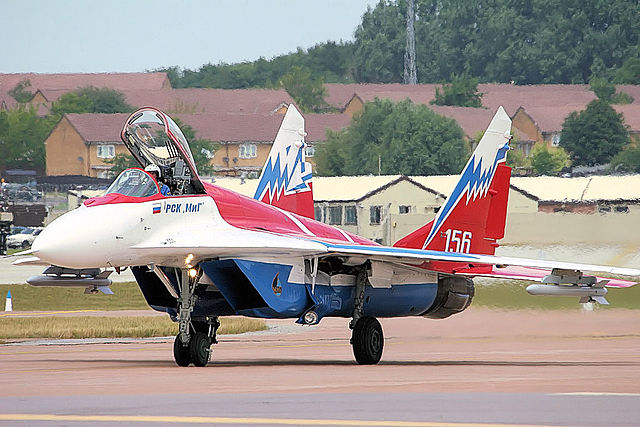
MiG-33, MiG-29ME
This is the export version of the MiG-29M. Traditionally it has been the practice for export versions of Soviet military aircraft to be downgraded in weapons and avionics, but a bad economic situation in the 1990s force OKB and MAPO-MiG in desperately need to find customers.
MIG-29M specification
- Crew: 1 or 2
- Length: 17.37 m (57 ft 0 in)
- Wingspan: 11.4 m (37 ft 5 in)
- Height: 4.73 m (15 ft 6 in)
- Wing area: 38 m2 (410 sq ft)
- Empty weight: 13,380 kg (29,498 lb)
- Gross weight: 19,200 kg (42,329 lb)
19,000 kg (41,888 lb) for MiG-29M2
- Max takeoff weight: 26,500 kg (58,422 lb)
- Powerplant: 2 × Klimov RD-33MK afterburning turbofan engines, 88.26 kN (19,840 lbf) with afterburner
Performance
- Maximum speed: 2,100 km/h (1,300 mph, 1,100 kn) / M2.25 at high altitude
1,400 km/h (870 mph; 760 kn) / M1.13 at low altitude
- Range: 2,000 km (1,200 mi, 1,100 nmi)
1,700 km (1,100 mi; 920 nmi) for MiG-29M2
- Ferry range: 3,000 km (1,900 mi, 1,600 nmi) with 3x drop tanks
2,700 km (1,700 mi; 1,500 nmi) for MiG-29M2
- Service ceiling: 16,000 m (52,000 ft)
16,200 m (53,150 ft) for MiG-29M2
- g limits: +8 to +9
- Rate of climb: 330 m/s (65,000 ft/min)
- Wing loading: 442 kg/m2 (91 lb/sq ft)
- Thrust/weight: 1.02
Armament
- Guns: 1 × 30 mm Gryazev-Shipunov GSh-30-1 autocannon with 150 rounds
- Hardpoints: 7 × hardpoints (6 × underwings, 1 × fuselage) with a capacity of up to 5,500 kg (12,100 lb) of stores, with provisions to carry combinations of:
- Rockets:
- 4 × S-8
- 6 × S-25
- Missiles:
- Air-to-air missiles:
- 4 × R-73E
- 4 × RVV-AE
- 4 × R-27R/ER/T/ET
- Air-to-surface missiles:
- 2 × Kh-29L/T/D
- Anti-ship missiles:
- 2 × Kh-31A
- 2 × Kh-35U
- Anti-radiation missiles:
- 2 × Kh-31P
- Bombs:
- 2 × KAB-500KR TV-guided bombs
- 2 × KAB-500L laser-guided bombs
- 2 × KAB-500OD bombs
Avionics
- Phazotron Zhuk-M / Zhuk-ME radar
- OEPS-29 electro-optical targeting system
MiG-29KVP
In 1981 the Soviet Navy announced a requirement for all-weather interceptors able to operate from the four large ‘cruiser-carriers’ then being built. The main requirement for the Soviet Navy was a new supersonic carrier-based fighter.
The Mikoyan OKB naturally decided to compete for this requirement, and quickly came to the conclusion that they could use the proven design of MIG-29M and develop a naval version of MIG-29M. This aircraft was designated MIG-29KVP. The new MiG-29KVP is fitted with a stronger undercarriage and a reinforced tail section with an arrestor hook.
Several hundred test flights were made from normal runways, from a dummy carrier deck at Saki in the Crimea, from a trampoline (ski jump) at Saki and from the Tbilisi.
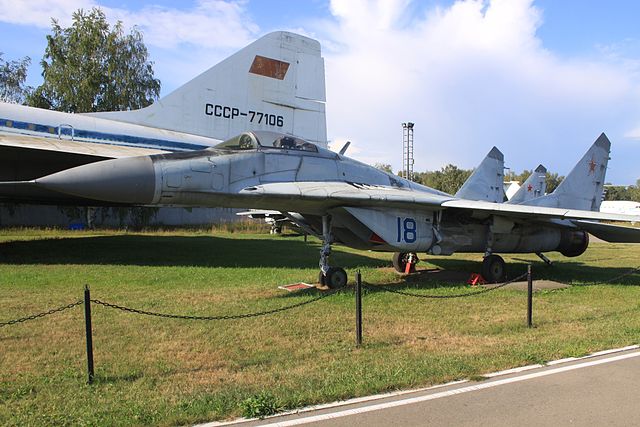
MiG-29K “9-31” Fulcrum D
The detailed design of the carrier-based naval fighter began in 1985. It was based upon the 9-15, MiG-29M. The landing gear and hook are similar to those of the MiG-29KVP, with the addition of the nose leg of a vertical row of red/green/amber ‘traffic lights’. A spotlight illuminates the hook to make its absence obvious to the LSO at night.
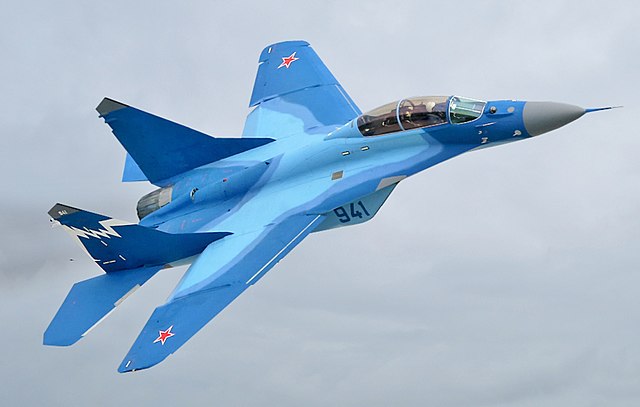
MiG-29K Specifications
- Crew: 1 or 2
- Length: 17.3 m (56 ft 9 in)
- Wingspan: 11.99 m (39 ft 4 in)
- Height: 4.4 m (14 ft 5 in)
- Wing area: 43 m2 (460 sq ft)
- Empty weight: 11,000 kg (24,251 lb)
- Gross weight: 18,950 kg (41,778 lb)
- Max takeoff weight: 24,500 kg (54,013 lb)
- Powerplant: 2 × Klimov RD-33MK afterburning turbofan engines, 88.3 kN (19,900 lbf) with afterburner
Performance
- Maximum speed: 2,200 km/h (1,400 mph, 1,200 kn) / M2+ at high altitude
1,400 km/h (870 mph; 760 kn) / M1.13 at low altitude
- Cruise speed: 1,500 km/h (930 mph, 810 kn) / M1.21
- Range: 1,500 km (930 mi, 810 nmi) at high altitude
700 km (430 mi; 380 nmi) at low altitude
- Combat range: 850 km (530 mi, 460 nmi)
- Ferry range: 2,000 km (1,200 mi, 1,100 nmi) internals
3,000 km (1,900 mi; 1,600 nmi) with 3 drop tanks
5,500 km (3,400 mi; 3,000 nmi) with 3 drop tanks + one aerial refuelling
- Service ceiling: 17,500 m (57,400 ft)
- g limits: +8
- Rate of climb: 330 m/s (65,000 ft/min) initial
109 m/s (358 ft/s) average from 0–6,000 m (0–19,685 ft)
- Wing loading: 442 kg/m2 (91 lb/sq ft)
- Thrust/weight: 0.97
Armament
- Guns: 1 × 30 mm Gryazev-Shipunov GSh-30-1 autocannon with 150 rounds
- Hardpoints: 8 × including the ones on multi-lock bomb carriers with a capacity of up to 5,500 kg (12,125 lb) of stores, with provisions to carry combinations of:
- Rockets:
- S-5
- S-8
- S-24
- Missiles:
- Air-to-air missiles:
- 8 × R-73E
- 6 x RVV-AE
- Astra (Indian Navy)
- Anti-ship missiles:
- 4 x Kh-31A/AD
- 4 x Kh-35U/UE
- Anti-radiation missiles:
- 4 x Kh-31P/PD
- Bombs:
- 4 x KAB-500KR TV-guided bombs
- 4 x KAB-500L laser-guided bombs
Others:
- Flare dispenser pod and chaff pod or
- Electronic countermeasures (ECM) pod or
- Targeting pods or
- Drop tanks
Avionics
- Phazotron Zhuk-ME radar
- OEPS-29 electro-optical targeting system
The development of the MiG-29K was terminated in 1993. In 1997, however, negotiations with India for the purchase of the carrier Admiral Gorshkov open project again. MAPO-MiG dusted off the entire MiG-29K program and MIG-29K become a major type for the Indian Navy.
MIG-29KUB Fulcrum D
Aircraft is needed to teach pilots to operate the MiG-29K from carrier decks. The solution was MIG-29KU, but the project is terminated in 1993. The possibility of adding a stronger landing gear and a hook to the MiG-29 UB was examined, but it was concluded that in a high-AOA carrier approach the instructor’s view would be inadequate. Accordingly, the MIG-29KUB (ship trainer) was projected, with the rear cockpit considerably raised. The first MiG-29KUB is developed for the Indian Navy. The first flight was at the Russian Zhukovsky aircraft test center on 22 January 2007.

